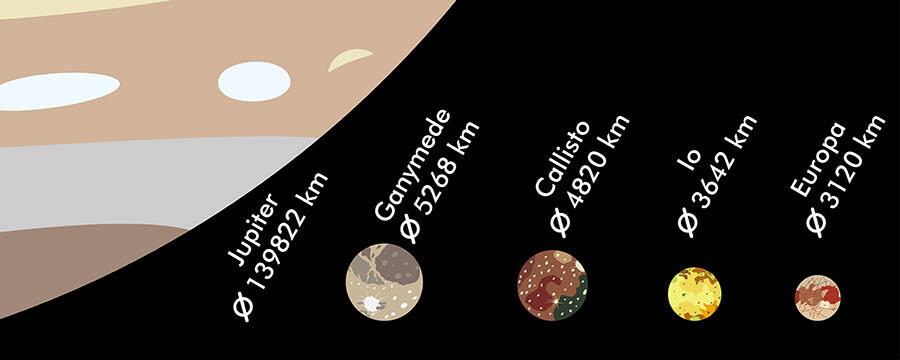13 Io Moon Facts | Fiery Facts about Io
If you’re looking to learn some facts about the moon Io, then you’re in luck. This moon famous for it’s large volcanoes and sky high temperatures has been the study of many astronomers over the years who wonder how it was formed. Lets learn some of the facts about the moon, Io.
- Io is one of the four Galilean moons. They are named this because they were all discovered first of Jupiter‘s moons, by Galileo Galilei.
- Io is the closest moon to Jupiter out of the Galilean moons, and the 5th closest out of all it’s moons.
- It has a radius of 1,131.7 miles (1,821km). This makes it the 3rd largest of the 4 main moons.
- Io orbits Jupiter at an approximately 262,000 mi (421,700 km) distance from the planets center.
- Io takes it’s name from Greek mythology. Io was a priestess of the Goddess Hera, wife of Zeus. Io became one of Zeus’s many lovers, which is where all the 4 Galilean moons take their name from.
- Io is known for it’s volcanos, with some people calling it the volcano moon. It has the most active volcanoes of any moon or planet.
- It has hundreds of volcanoes on it’s surface, the biggest of which is called Loki Patera. This volcano has a 126 mile (202km) diameter.
- Like some other large moons, Io actually has it’s own atmosphere, although it is quite thin. It is primarily made up of sulfur dioxide.
- Io has a yellow surface, due to the high amount of sulfur and volcanic activity.
- Io was formed approximately 4.5 billion years ago, along with the rest of the solar system.
- It takes little Io around 42 hours for it to complete one full orbit of giant Jupiter.
- We don’t think there’s any water under the surface of Io, like there is with many other moons. Instead, the mantle of Io is primarily made up of forsterite, and it’s core is likely molten and solid iron.
- We know a lot more about Io than we have done in the past thanks to NASA spacecraft Juno, which is still orbiting Jupiter after it’s launch in 2011.
 Io with the other Galilean moons Europa, Callisto and Ganymede
Io with the other Galilean moons Europa, Callisto and Ganymede
Out of all of the moons that orbit Jupiter, Io might be the least habitable! The surface of Io is covered in volcanoes that are completely active, and can project lava for miles and miles. As well as this, whilst Io has an atmosphere, most of it is made up of sulfur, with no oxygen for humans to breathe. Plus, the 3 other Galilean moons have water beneath their surface – we don’t think this is the case for fiery Io.
Io, like many planets and moons, takes it’s name from Greek mythology. Io was a mortal princess who eventually becomes the mistress of Zeus, which obviously Zeus’s wife Hera didn’t appreciate. So, the myth says that either Hera turned Io into a cow herself, or Zeus done this to hide her from his wife. All of the moons of Jupiter are named after Zeus’s mistresses.
Why are the other moons so cold on their surface and iced over, whilst Io is so hot and covered in volcanoes? It’s a valid question, and different astronomers believe there are different reasons for Io’s hot surface. The main theory is that the cause of Io’s hot temperature is something called tidal heating, which is essentially friction caused by the gravity of Jupiter.
Yes, the volacnoes on the surface of the moon Io are very active! If you want to see exactly how active they are, then this 5 year journal of Io’s volcanic activity can give you more insight into just how active this moon is.
So, there we have it. Io, the most active object in the entire solar system with the hottest surface is really a strange one. Considering it is surrounded by freezing cold moons, discovering Io in more depth has been very important to astronomers to know the different possibilities to what’s out there – it isn’t all just frozen rocks when you get past Mars!